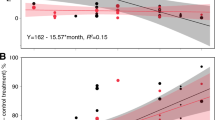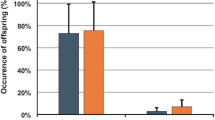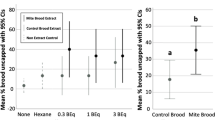Abstract
Honeybees, Apis mellifera, selected for the hygienic removal of freeze-killed brood (FKB), resist several microbial diseases and have some resistance to Varroa destructor. Bees with Varroa-sensitive hygiene (VSH) have good resistance to V. destructor. We determined whether the response to FKB could be used to select for VSH by measuring the responses of different bees (VSH, FKB-selected, F1 VSH, and unselected control) to combs with FKB and combs with mite-infested brood. All bee types completely removed much FKB (77–88 %) within 24 h. The removal of mite-infested brood after 1 week was much more variable among bee types (VSH, 66 %; F1 VSH, 51 %; FKB hygienic, 14 %; control, 3 %). There was some relationship between 24-h manipulation of FKB cells (i.e., cell contents at least partially removed) and the removal of mite-infested brood, but this appears to have little practical relevance because of a large inherent variation.





Similar content being viewed by others
References
Boecking, O., Drescher, W. (1992) The removal response of Apis mellifera L. colonies to brood in wax and plastic cells after artificial and natural infestation with Varroa jacobsoni Oud. and to freeze-killed brood. Exp. Appl. Acarol. 16, 321–329
Harbo, J.R., Harris, J.W. (2001) Resistance to Varroa destructor (Mesostigmata: Varroidae) when mite-resistant queen honey bees (Hymenoptera: Apidae) were free-mated with unselected drones. J. Econ. Entomol. 94, 1319–1323
Harbo, J.R., Harris, J.W. (2005) Suppressed mite reproduction explained by the behaviour of adult bees. J. Apic. Res. 44, 21–23
Harbo, J.R., Hoopingarner, R.A. (1997) Honey bees (Hymenoptera: Apidae) in the United States that express resistance to Varroa jacobsoni (Mesostigmata: Varroidae). J. Econ. Entomol. 90, 893–898
Ibrahim, A., Spivak, M. (2006) The relationship between hygienic behavior and suppression of mite reproduction as honey bee (Apis mellifera) mechanisms of resistance to Varroa destructor. Apidologie. 37, 31–40
Ibrahim, A., Reuter, G.S., Spivak, M. (2007) Field trial of honey bee colonies bred for mechanisms of resistance against Varroa destructor. Apidologie 38, 67–76
Jay, S.C. (1962) Colour changes in honey bee pupae. Bee World 43, 119–122
Lapidge, K.L., Oldroyd, B.P., Spivak, M. (2002) Seven suggestive quantitative trait loci influence hygienic behavior of honey bees. Naturwissenschaften 89, 565–568
Oxley, P.R., Spivak, M., Oldroyd, B.P. (2010) Six quantitative trait loci influence task thresholds for hygienic behaviour in honeybees (Apis mellifera). Mol. Ecol. 19, 1452–1461
Parker, R., Guarna, M.M., Melathopoulos, A.P., Moon, K.-M., White, R., Huxter, E., Pernal, S.F., Foster, L.J. (2012) Correlation of proteome-wide changes with social immunity behaviors provides insight into resistance to the parasitic mite, Varroa destructor, in the honey bee (Apis mellifera). Genome Biol. 13, R81. doi:10.1186/gb-2012-13-9-r81
Rinderer, T.E., Harris, J.W., Hunt, G.J., de Guzman, L.I. (2010) Breeding for resistance to Varroa destructor in North America. Apidologie 41, 409–424
Rosenkranz, P., Aumeier, P., Ziegelmann, B. (2010) Biology and control of Varroa destructor. J. Invertebr. Path. 103, S96–S119
SAS Institute Inc. (2009) SAS OnlineDoc® 9.3. SAS Institute Inc., Cary, NC
Spivak, M. (1996) Honey bee hygienic behavior and defense against Varroa jacobsoni. Apidologie 27, 245–260
Spivak, M. (2011) Laying groundwork for a sustainable market of genetically-improved queens: the Bee Team. Am. Bee J. 151, 483–485
Spivak, M., Reuter, G.S. (1998) Honey bee hygienic behavior. Am. Bee J. 138, 283–286
Spivak, M., Gilliam, M. (1998a) Hygienic behaviour of honey bees and its application for control of brood diseases and Varroa. Part I. Hygienic behaviour and resistance to American foulbrood. Bee World 79, 124–134
Spivak, M., Gilliam, M. (1998b) Hygienic behaviour of honey bees and its application for control of brood diseases and Varroa. Part II. Studies on hygienic behavior since the Rothenbuhler era. Bee World 79, 169–186
Spivak, M., Reuter, G.S. (2001) Varroa destructor infestation in untreated honey bee (Hymenoptera: Apidae) colonies selected for hygienic behavior. J. Econ. Entomol. 94, 326–333
Spivak, M., Reuter, G.S., Lee, K., Ranum, B. (2009) The future of the MN hygienic stock of bees is in good hands! Am. Bee J. 149, 965–967
Strange, J.P., Calderone, N.W. (2009) Evaluation of apicultural characteristics of first-year colonies initiated from packaged honey bees (Hymenoptera: Apidae). J. Econ. Entomol. 102, 485–492
Tsuruda, J.M., Harris, J.W., Bourgeois, L., Danka, R.G., Hunt, G.J. (2012) High-resolution linkage analyses to identify genes that influence Varroa sensitive hygiene behavior in honey bees. PLoS ONE 7(11), e48276. doi:10.1371/journal.pone.0048276
Villa, J.D., Danka, R.G., Harris, J.W. (2009) Simplified methods of evaluating colonies for levels of Varroa Sensitive Hygiene (VSH). J. Apic. Res. 48, 162–167
Acknowledgments
David Dodge, Victor Rainey, and Daniel Winfrey (USDA-ARS) provided excellent technical assistance. Amy Weeks (Beeline Apiary) created the Minnesota hygienic bees in cooperation with Jeff Hull (Hull Apiaries). Debbie Boykin (USDA-ARS) gave statistical advice.
Author information
Authors and Affiliations
Corresponding author
Additional information
Manuscript editor: Stan Schneider
Adéquation variable des réponses ‘hygiéniques’ vis-à-vis de Varroa destructor et de couvain congelé parmi différents types d’abeilles
Apis mellifera / hygiène / Varroa destructor / résistance aux acariens / élevage
Unterschiedliche Übereinstimmung der hygienischen Antwort auf Varroa destructor und gefriergetötete Brut bei unterschiedlichen Typen von Honigbienen
Apis mellifera / Hygiene / Varroa destructor / Milbenresistenz/Züchtung
Rights and permissions
About this article
Cite this article
Danka, R.G., Harris, J.W., Villa, J.D. et al. Varying congruence of hygienic responses to Varroa destructor and freeze-killed brood among different types of honeybees. Apidologie 44, 447–457 (2013). https://doi.org/10.1007/s13592-013-0195-8
Received:
Revised:
Accepted:
Published:
Issue Date:
DOI: https://doi.org/10.1007/s13592-013-0195-8




